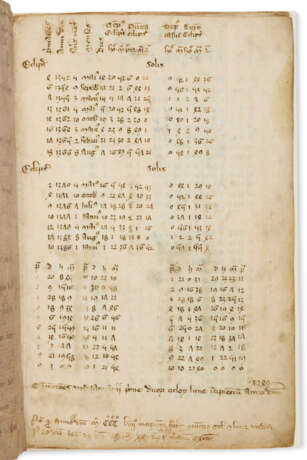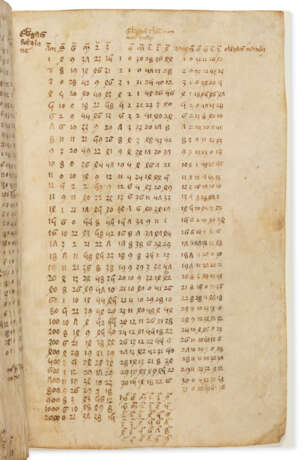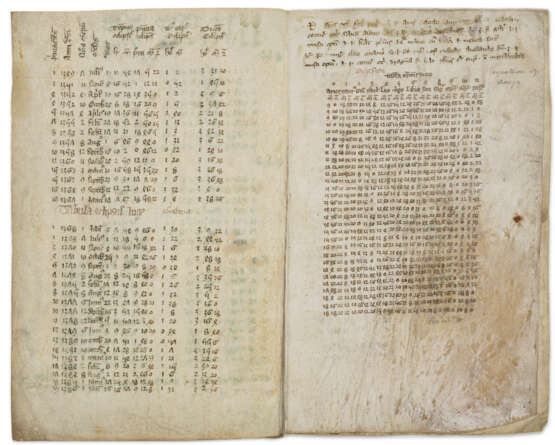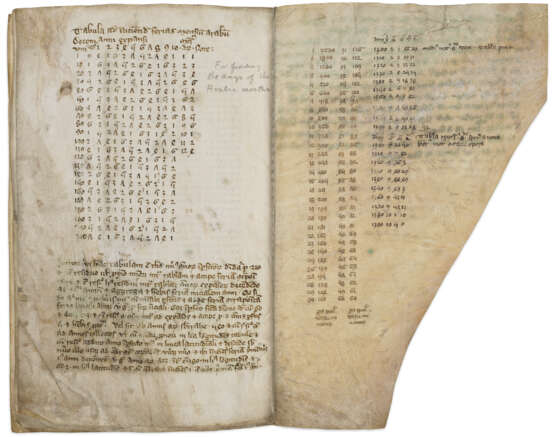ID 1360851
Lot 135 | Astronomical tables for 1349-1386
Valeur estimée
$ 10 000 – 15 000
A fascinating insight into the development of medieval astronomy in England: 14th-century computational tables likely written in Oxford, those for the solar and lunar eclipses drawing on Walter of Elveden's Kalendarium.
c.248 x 162mm. i + 5 leaves of astronomical computational tables, the front pastedown from a 13th-century English Antiphonal with the notation and initials left blank, the text from the Feast of the 3rd Sunday after Epiphany (small hole to the front pastedown, lower corner of f.5 cut, some marginal soiling, a few stains and light creasing, occasional green discoloration from ink). Modern archival paper wrappers; custom box.
Provenance:
(1) The script is English, and the manuscript was perhaps in Oxford in 1357 when the conjunction of the sun and the moon was recorded on 20 January according to Oxford meridian: "[...] anno domini MCCC lvii incipiente fuit coniunctio sol et lune [...] per meridionem oxoniensem" (f.1). A later hand on f.1v attributes the table of the lunar eclipses from 1349-1386 to "Elvedene" – this is the astronomer Walter of Elveden (see below) – and the table for the equation of days on f.2 to "Rocheforde".
(2) An ?18th-century title on f.3v "Liber Plantarum & Herbarum" indicates that the present manuscript may have preceded a larger volume.
(3) Lt. Col. Hugh Levin (1886-1972), of Corby Castle: typed letter signed ‘B[ertram] Schofield’ (1896-1998), Deputy Keeper of Manuscripts at the British Museum addressed to him and dated 30 June 1948 tipped into inside upper wrapper. Hugh Levin was the second husband of Ursula Mary Howard, who had inherited Corby Castle in Cumbria on the death of her father Philip John Canning Howard in 1934.
(4) Sotheby’s, 8 December 1981, lot 79 to:
(5) Alan G. Thomas (1911-1992), English bibliophile and antiquarian.
Contents:
Table of solar eclipses 1352-1386, with additions at the foot of the page mentioning a conjunction of 1349 and the conjunction of the sun and the moon in 1357, f.1; table of lunar eclipses 1349-1386, f.1v; table of the equation of days, starting with Aries, f.2; motions of the sun and the moon, f.2v; elongation of the sun and the moon, f.3; table of the motion of the eighth sphere f.3v; "Tabula de corda et arcu" f.4; table for finding the days of the Arabic months f.4v; table of the recession of the eighth sphere from the ninth: "Tabula recessionis 8° spere a nona / verus motus octave spere", f.5; instructions in French on when to perform the sign of the cross f.5v.
The solar and lunar eclipses tables are derived from the Kalendarium of Walter of Elveden, scholar at Gonville Hall, Cambridge, matching the tabulated data in Cambridge, Corpus Christi College, MS 37, ff.43v-43v, with Elveden’s end-date of 1386. "Ironically, Elveden’s astrological efforts were better received in Oxford than in Cambridge—William Rede (d. 1385) and John Ashenden (d. in or before 1368?), both fellows of Merton College, consulted his astrological tables and almanac, and the late fourteenth-century Oxford Carmelite Nicholas Lynn published a famous continuation of the Kalendarium" (ODNB).
The present booklet bears similarities to a manuscript at the Royal Astronomical Society in London, QB.7/1021, also written at Oxford in the 14th century, and containing tables from 1340 ascribed to William Rede, tables of planetary equations ascribed to John of Lignéres, and, as in the present manuscript, "tabula motus 8e spere", "tabula de corda et arcu" and "tabula equacionis dierum". That manuscript too contains a pastedown taken from a small English Antiphonal, where the spaces for music and initials have been left blank.
| Lieu d'origine: | Angleterre |
|---|---|
| Catégorie maison de vente aux enchères: | Lettres, documents et manuscrits |
| Lieu d'origine: | Angleterre |
|---|---|
| Catégorie maison de vente aux enchères: | Lettres, documents et manuscrits |
| Adresse de l'enchère |
CHRISTIE'S 20 Rockefeller Plaza 10020 New York Etats-Unis | ||||||||||||||
|---|---|---|---|---|---|---|---|---|---|---|---|---|---|---|---|
| Aperçu |
| ||||||||||||||
| Téléphone | +1 212 636 2000 | ||||||||||||||
| Fax | +1 212 636 4930 | ||||||||||||||
| Conditions d'utilisation | Conditions d'utilisation | ||||||||||||||
| transport |
Service postal Service de messagerie ramassage par vous-même | ||||||||||||||
| Modes de paiement |
Virement bancaire | ||||||||||||||
| Heures d'ouverture | Heures d'ouverture
|






